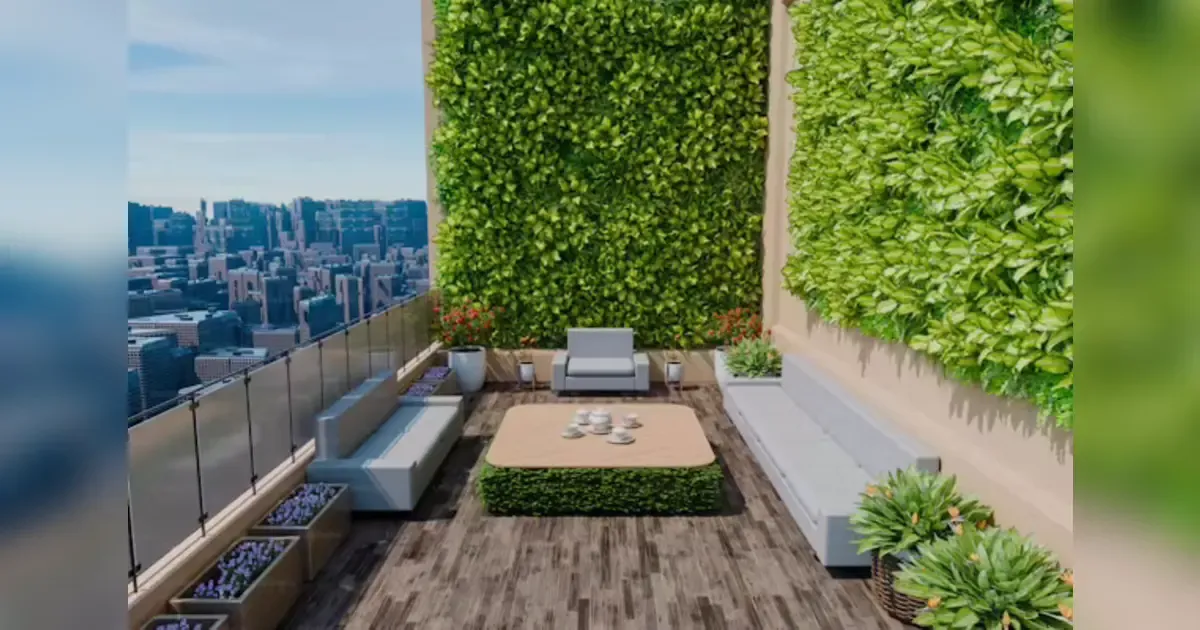In as much as playing outdoor structures, children need to know how to live sustainably outside, using sustainable materials, using less water, occupying structures that support wildlife, and minimizing wastes. Such practices act as methods of environmental conservation as your outdoor space gains aesthetic appeal and utility....
How to Create a Sustainable Outdoor Living Space
Introduction
Establishing an enduring area that is both inside and out is useful to living and also protects Natural Resource. It allows you to help neighborhood businesses, reuse and reduce waste, and design an elegant, practical space that improves your living space. There is a marked increase in sustainable outdoor design since everyone is concerned about adopting green practices in their lives. From utilizing recycled material, and saving water or planting native plants in your garden, creating a sustainable outdoor environment not only adds the aesthetic value of a compound but also play a major role in conservation. Part one of this guide is therefore aimed at giving you more ideas on how you can convert your outdoor space to an environmentally friendly paradise of beauty and purpose.
Select for Green Building Materials
In designing an environmentally friendly outdoor area, landscaping should consider the appropriate green items to use. With reclaimed materials, you can save the environment and get a long lasting and beautiful space in a few years. For instance, the ‘composite’, which is mostly produced from recycled plastics and wood fiber, is easy to maintain, durable and eco-friendly. Besides, repurposed timber and rescued bricks will help create an individual and warm atmosphere and will not require cutting down a tree or quarrying bricks. If wanting new wood, there are FSC certified woods, which means that the wood is sourced responsibly. Faster growing renewable such as bamboo, are perfect for putting up fences or making furniture; they are warm and relatively stylish, without imposing social cost. For pathways and patios, natural stone, gravel or decomposed granite used as surface can let rain to infiltrate the ground and promotes a good growth of healthy soils and non-erosion. It is even possible to purchase sealers that have very low VOC levels or no VOC at all, thus sparing people and wildlife in your garden from exposure to dangerous chemicals.
Conserve Water with Efficient Landscaping
Water-saving should also not be ignored in any other use of space and especially a green space in a region that experiences dry weather, or has water rationing. Drought-tolerant plants such as Cactus, lavender, bell, flower, and ornamental grasses require less water and there is hardly any need to water them frequently. Another option is using native species because they cope well with local climate and attract native pollinators thus supporting species richness. In the case of irrigation, a drip irrigation technique delivers water to the roots of plants by an appropriate method that avoids evaporation and the drainage of excess water. Bend the drip system even further by hooking a timer to the system in order to water your plants only when it is required. Another sensible model of how to save water is rainwater harvesting. Use of rain barrels to directly collect runoff from roofs offers you saved water for use in the garden thus limiting rain water from the municipality tap. Organic mulch helps to control the evaporation of moisture hence reducing the frequency of water irrigation helps to eradicate weeds and at the same time as it decomposes it improves the fertility of the soils.
Utilize Eco-Friendly Lighting
Reliable illumination is always a critical factor for any green environment since it helps in cutting costs and unnecessary emission of light. Path, patio, garden and anything you want to light up at night because solar lights do not need wiring, powered by sun, and are switched on by themselves when it is evening. LEDs are also now affordable and use up to 80% less power than incandescent bulbs and have a much longer lifespan. It is also possible to mount motion sensors or timers specifically to outdoor lights, in order to maximize energy saving – these devices switch on the lights only when it is necessary. Choosing the dark sky friendly lighting also plays a big role in reduction of light pollution hence ensuring that the night sky is not tampered with or affecting the wild-life at night. These lights have been designed to direct light downwards with the view to outlining only the necessary areas and at the same time, eliminating glare of adjacent regions.
Create a Pollinator-Friendly Garden
A pollinator-friendly garden is an important part of successful outdoor design because of the need to support other species to ensure the general wellbeing of the ecosystem. Perennials including coneflowers, milkweed and asters which provide food for bees, butterflies and birds and support native plant wildlife. Therefore, preventing the use of pesticides is critical in purposes of conserving these useful insects since usage of chemicals affects the pollinators. Pick earth friendly pest control techniques like neem oil or garlic spray for your plants without harming the pollinators. Access to water another basic need is another easy method you can use to support wildlife in your garden, you can have a water source for pollinators to drink. A saucer of stones set in water, or a dish of water together with pebbles makes a water source with which bees, butterflies and birds can drink, especially during a hot day. Single tips that will help to enhance the flowers’ ability for attracting certain pollinators are: Growing flowers in different colors, shapes and sizes and varieties so as to ensure that there are flowers in all parts of the garden and during all the seasons of the year.
Reduce Waste with Sustainable Practices
Minimization of waste is a principle basic to sustainable architecture and you can adopt it in your plan on the porch. Yard waste and food scraps might be controlled via composting, which is also an excellent source of fertilizer for plants. Instead of using plastic utensils which are used once then thrown away, use friendly gardener tools which are strong and long-lasting tools and garden shears and trowels of metal or hardwood that has been harvested in a mature and sustainable way. Designing irrigation systems from upcycled material such as the old tires, pallets or containers is efficient besides decorating your landscape, then it prevents wastage. For pest control: natural pest attractants consisting of beneficial insects useful to food production without using any chemicals. Organic control techniques are efficient, harmless and eco-friendly within the pest management process.
Select Eco-Friendly Furniture and Decor
Furnishing options and accessories will also contribute to the optimization of the sustainability of the outdoor environment. Purchasing furniture that is made of wood, metal that has been recycled or bamboo decreases the impact that you have on the environment. Second-hand furniture also includes those of vintages, they too serve as friendly to the environment since they help cut down on production of new furniture and in effect prevents wastes that are accumulated end up in a dump. You can breathe new life into second hand pieces by simply painting or staining them to give them that distinct style you want. Further, dependent functional furniture such as benches that also serve as storage, or tables that convert into others add to sustainable design by minimizing the need for other products. Check for specific outdoor rugs that are made from recycled products such as PET plastic or select only for those pieces that may be effectively recycled upon reaching their useful life.
Encourage Wildlife Habitats
It is always a great idea to support local wildlife in your outdoor space is a fulfilling lotion towards enhancing the diversification of species. Birdhouses, feeders, and native shrubs or trees though being feeders for different species of birds, butterflies, and insects provide shelter and food necessities in the garden. Planting native trees and shrubs develops the layers in your garden thus providing shelter to a variety of animals. If there is a possibility to place a small pond or water feature, do it; it invites frogs, dragonflies, and other beneficial species, top of that it brings an aesthetic plus. Rock piles, brush, or fallen logs make good homes for lizard, insects or small animals which in turn support the natural life of the area.
Adopt Sustainable Cooking and Heating Solutions
Those who love to host exterior events, the green technologies can let you to cook and heat without harming the planet. It is suggested to use ethanol or bioethanol fire pit since it emits less than the fire pits that use wood. There are the types of stoves, including the solar ovens and grills that are preferred from the stand point of sustainability since they feed directly on the sun’s energy in the cooking process and hence no use of fossil fuel. Infrared heaters are also economical and unique upsetting in that they direct heat toward the people and not the surfaces. In areas where the sun is shining most of the time, solar heaters are good if you need to heat the outdoors when the weather is cold.
Plan for Seasonal Sustainability
Sustainability does not only mean one time incorporation and utilization while designing an outdoor area but a constant process. Seasonal planning or thinking about how to manage your garden throughout the different seasons is a good strategy in managing your garden throughout without harming the environment. opt for those plants which can grow during a particular season without the use of artificial astringents or large amounts of water. Also, when it is too cold outside it beneficial to have furniture that can be easily covered or put away hence, they will last longer. Integration of rain garden or use of frost-resistant plants enables control and management of rainfall water after some time giving long-term result on the environment. If your climate is seasonal, there should be structures put in place to shield your plants from either very strong winds or strong sun. All these steps enable you to get the best out of your landscape no matter the season without overstretching your effort or budget.
Conclusion
Developing a sustainable landscape design will provide you and your family with an opportunity to enjoy an improved surrounding environment. Through using eco-friendly materials, saving water and electricity, growing native bees’ friendly gardens, minimizing the use of plastics and reducing pests, you are creating a space that could be mutually advantageous for you and the earth. People are likely to appreciate ecofriendly furniture, sustainable ways of cooking, and wildlife accommodation in their exterior spaces which are meaningful extensions of living sustainably. In addition to answering a need for social relaxation, this space serves to responsibly support biological variety, balanced resource use, and, hopefully, a lifelong friendship with nature. In this way, the outside space becomes the colorful, environmentally friendly area, from which emerges sustainable happiness and objective of your home.
In return by adopting a DIY green approach towards the design of your outside living area you are promoting the culture of environmentalism. There is no superfluous action in the process, from selecting the correct materials to using carefully integrated irrigation systems, which are all part of the Grand Strategy to decrease our individual environmental impact. In the same respect, as sustainable practices develop, so too can the methods by which we plan, maintain, and appreciate our exteriors, and thus aiding the formation of the ideal existence of human and environment. When you opt for sustainable outdoor haven, you can have good view and serenity of nature together with making a long-term positive change in the earth. Through the implementation of these sustainable approaches, you make the space as timeless beautiful and meaningful as possible, which again shows that sustainability can be both luxurious and responsible.


























